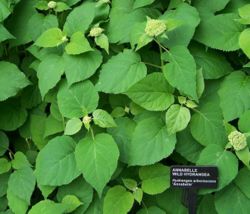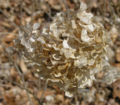Hydrangea arborescens
| subsp. var. | ||||||||||||||||||||||||||||||||||||||||||||||||||||||||
|---|---|---|---|---|---|---|---|---|---|---|---|---|---|---|---|---|---|---|---|---|---|---|---|---|---|---|---|---|---|---|---|---|---|---|---|---|---|---|---|---|---|---|---|---|---|---|---|---|---|---|---|---|---|---|---|---|

|
|
| ||||||||||||||||||||||||||||||||||||||||||||||||||||||
| ||||||||||||||||||||||||||||||||||||||||||||||||||||||||
| Standard Cyclopedia of Horticulture |
|---|
|
Viburnum americanum, Mill. (V. Opulus var. americanum, Ait. V. trilobum, Marsh. V. opuloides, Muhl. V. edule, Pursh. V. Oxycoccus, Pursh). Cranberry Bush. High Cranberry. Fig. 3928. Closely allied to the preceding species, but habit more open and spreading: lvs. with coarsely toothed or nearly entire lobes, pilose on the veins beneath or nearly glabrous, 2-5 in. long; petiole with shallow groove and small, usually stalked glands: cymes with shorter peduncles; stamens somewhat shorter. May, June: fr. in Aug., Sept. B.B. (ed. 2) 3:270 (as V. Opulus). New Bruns. to Brit. Col., south to N. J. and Ore.—Handsome native shrub, very decorative in fr., which begins to color by the end of July, remains on the branches and keeps its bright scarlet color until the following spring. The berries are not eaten by birds.
|
| Hydrangea arborescens {{{status}}} Fossil range: {{{fossil_range}}}
| ||||||||||||||||||||||||||||||||||||||||||||||||||||||||||||||||||
|---|---|---|---|---|---|---|---|---|---|---|---|---|---|---|---|---|---|---|---|---|---|---|---|---|---|---|---|---|---|---|---|---|---|---|---|---|---|---|---|---|---|---|---|---|---|---|---|---|---|---|---|---|---|---|---|---|---|---|---|---|---|---|---|---|---|---|
 | ||||||||||||||||||||||||||||||||||||||||||||||||||||||||||||||||||
| Plant Info | ||||||||||||||||||||||||||||||||||||||||||||||||||||||||||||||||||
| ||||||||||||||||||||||||||||||||||||||||||||||||||||||||||||||||||
| Scientific classification | ||||||||||||||||||||||||||||||||||||||||||||||||||||||||||||||||||
| ||||||||||||||||||||||||||||||||||||||||||||||||||||||||||||||||||
| [[{{{diversity_link}}}|Diversity]] | ||||||||||||||||||||||||||||||||||||||||||||||||||||||||||||||||||
| {{{diversity}}} | ||||||||||||||||||||||||||||||||||||||||||||||||||||||||||||||||||
| Binomial name | ||||||||||||||||||||||||||||||||||||||||||||||||||||||||||||||||||
| Hydrangea arborescens L | ||||||||||||||||||||||||||||||||||||||||||||||||||||||||||||||||||
| Trinomial name | ||||||||||||||||||||||||||||||||||||||||||||||||||||||||||||||||||
| {{{trinomial}}} | ||||||||||||||||||||||||||||||||||||||||||||||||||||||||||||||||||
| Type Species | ||||||||||||||||||||||||||||||||||||||||||||||||||||||||||||||||||
| {{{type_species}}} | ||||||||||||||||||||||||||||||||||||||||||||||||||||||||||||||||||
| {{{subdivision_ranks}}} | ||||||||||||||||||||||||||||||||||||||||||||||||||||||||||||||||||
| [[Image:{{{range_map}}}|{{{range_map_width}}}|]] | ||||||||||||||||||||||||||||||||||||||||||||||||||||||||||||||||||
| Synonyms | ||||||||||||||||||||||||||||||||||||||||||||||||||||||||||||||||||
| {{{synonyms}}} |
Hydrangea arborescens, commonly known as Wild Hydrangea or Smooth Hydrangea, is a species of Hydrangea native to eastern North America.
Cultivation
The cultivar 'Annabelle' is the best known of this species. It is one of the most cold hardy of Hydrangeas. The cultivar ‘Grandiflora’ has flowers that resemble snowballs, similar to Viburnum plicatum.
-
Hills-of-Snow Hydrangea "Grandiflora"
-
Wild Hydrangea v. Annabelle
Hydrangea arborescens -
Flowers of Smooth Hydrangea
External links
- Information on cultivar Annabelle
- Hydrangea arborescens Large-format diagnostic photos and information
- Hydrangea Thoughts I - Informative but non-scholarly essay on Hydrangea (Culture, History and Etymology).


